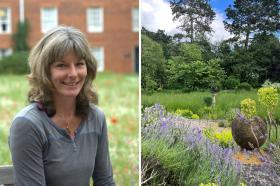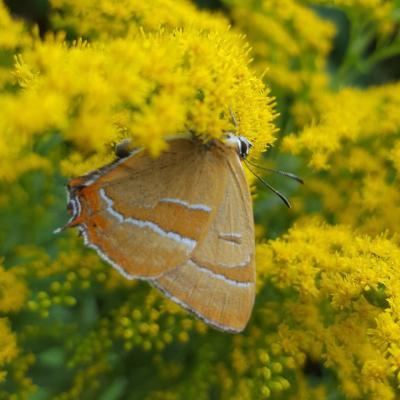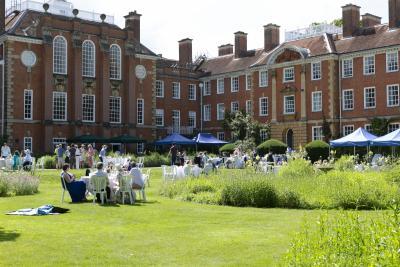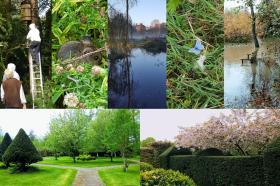
An interview with former Head Gardener Kate Hunt
As LMH's Head Gardener Kate Hunt prepared to say goodbye after more than 9 years tending the College's gardens, we spoke to her about how things evolved during her time here, the importance of biodiversity, and the future challenges facing our green spaces.
How long have you been at LMH?
I’ve been at LMH for nine and a half years, and Head Gardener for six and a half of those.
What did you make of the gardens when you first arrived, and how did you decide your plans and priorities?
I’ve always loved the LMH gardens, and saw my role as building on what others had already been doing for generations before me. My initial focus was on improving the large circle border in the formal gardens, and then on raising the general look of things, including tidying up paths and creating pot displays around College.
Where is your favourite spot in the LMH grounds?
I don’t think you can beat the benches down by the riverside.
What has been your favourite thing about working here?
I think the people and the culture at LMH are really special, and I will miss that a lot. I also love the wild feeling of the gardens and the connection with nature that they allow. There’s a really nice mix of more formal planting and areas where things are a bit wilder, and I think that’s really wonderful.

What has been your proudest achievement during your time here?
There are quite a few I could share with you, here are some highlights.
Firstly, a few years ago I had the opportunity to show Priscilla Tolkien, the daughter of J.R.R. Tolkien and an LMH alumna, around the gardens. I felt a bit intimidated as she knew the gardens very well and was friendly with the College’s former Head Gardener. It felt like a really big deal to meet her. She was such a nice lady, very warm and interested, and after her visit she wrote me a note on a postcard that had an illustration from one of her father’s books on the front. It was such a lovely note, in which she wrote about how beautiful the gardens are and that she knew they would continue to be so under my stewardship. I still have that little card, it really meant a lot to me.
In terms of the gardens themselves, a few things really stand out. I’m very proud of how we’ve created spaces for nature in the gardens, taking advantage of opportunities to improve biodiversity. When I first arrived at LMH someone told me that the very rare brown hairstreak butterfly nests here, but in spite of my best efforts I’d never managed to see one until last year completely by chance I saw one while taking photos of hummingbird moths in the gardens. I managed to take a few close-up shots of it, which was fantastic and I was really proud to capture it. I created an LMH biodiversity tour booklet a few years ago that highlights the range of wildlife habitats supported by the College’s outdoor spaces, and I’m really proud of the work we’ve done to nurture those spaces.
The wildflower meadow in Talbot Quad has also evolved during my time here. We worked hard to create a space that looked beautiful (for Instagram photos!) but was also a real haven for wildlife. Creating the ‘secret path’ through the flowers was challenging, and we had help from a student mathematician to get the calculations for the Fibonacci spiral just right!

What do you think the importance of the LMH grounds is? How has this developed during your time here?
For me, the real importance of the grounds is that they are a space for students to decompress, either through sports or just by being in nature. The wild areas down by the river are a great place for students and staff to walk and reflect, and I think that developing these wild pockets in College has been really positive. It sets LMH apart, and is very beneficial for student wellbeing, as well as being advantageous from a biodiversity perspective.
We’ve found ways to get students involved through a student gardening club, joint projects to create bug hotels, and doing the RSPB Big Garden Bird Watch. These things get students to connect with the gardens and feel their benefits.
Do you have a favourite season at LMH?
I love May and June, but every season is special in its own way. You become really aware of this when you work outside, every season has its own special light and quality.
What have been the biggest challenges you’ve had to overcome during your time here?
Definitely climate change. We’ve had long spells of dry weather, high winds, high heat, very heavy rain and flooding. The weather has become really unpredictable and it is difficult for nature to adjust to changes and hard for us to keep the garden looking good. There are also some pests, like the box moth, which have really benefitted from these conditions and that also creates challenges for us. A lot of damage has been caused in the last year by these extreme weather patterns - we lost many plants over the winter, and last summer the extreme heat also took a toll.
What are you going on to do next?
I’m hoping to make use of our camper van over the summer!
Photo credit: Kate Hunt



